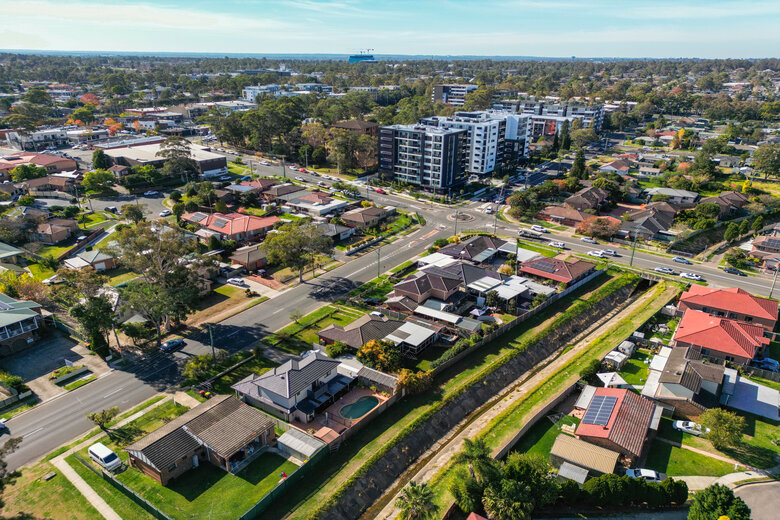
The NSW government will introduce reforms that override council planning powers in low and medium density areas.

The move is an attempt to fast track developments – including flats of up to six storeys, terraces, town houses and duplexes – in areas where they are presently not allowed.
Currently, councils have their own rules for the kind of homes that can be built within their LGA. But the government says these aren’t the types of homes needed for the future.
Planning minister Paul Scully says the ‘bold reforms’ will create tens of thousands of new low and mid-rise homes.
“Sydney is one of the least dense cities in the world but fewer than half of councils allow for low and mid-rise residential buildings in areas zoned for such homes,” Mr Scully said.
“We’re confronting a housing crisis so we need to change the way we plan for more housing, we can’t keep building out we need to create capacity for more infill, with more diverse types of homes.”
Capacity for 112,000 new homes
He says the reforms will create capacity for developers to deliver up to an estimated 112,000 new homes across the Greater Sydney region, Hunter, Central Coast and Illawarra.
The changes will allow:
- dual occupancies in all R2 low density residential zones across all of NSW
- terraces, townhouses and two storey apartment blocks near transport hubs and town centres in R2 low density residential zones across the Greater Sydney region, Hunter, Central Coast and Illawarra
- mid-rise apartment blocks near transport hubs and town centres in R3 medium density zones
The government will introduce a State Environmental Planning Policy (SEPP), which overrules council LEPs, to enact the changes ‘while simultaneously encouraging councils to add these types of dwellings to their own planning rules’, the minister said.
Addressing the ‘missing middle’
Mr Scully says it comes after the government last month identified a gap in the approval of density, with terraces and 1-2 storey unit blocks allowed under R2 (low density) zoning in only two of 32 Local Environmental Plans, or just six per cent of the LEPs across Sydney.
Meanwhile, residential flat buildings of any scale are prohibited in sixty percent of R3 (medium density) zones across Sydney.

Local Government NSW President Cr Darriea Turley said it was critical that democratically elected local councils retained the right to make decisions in the best interests of their communities.
“There are no cookie cutter solutions to the housing crisis, which is why council planning rules have always reflected their communities’ vision rather than the wishes of developers,” she said.
“While we don’t shy away from the need for more housing, it’s councils who undertake the strategic planning for their communities based on the capacity of services and the availability of infrastructure.”
Developers have hailed the announcement, saying it will prevent councils from using local planning controls to ‘switch off’ apartment developments.
“Urban Taskforce has been calling for reform in the ‘missing middle’ exactly along the lines of the announcement today, Urban Taskforce CEO Tom Forrest said.
“The very welcome message to local councils is clear: change your approach or it will be changed for you.”
Consultation will run until February, 2024 with the SEPP to apply from a date to be announced after that.
Comment has been sought form LGNSW.
Comment below to have your say on this story.
If you have a news story or tip-off, get in touch at editorial@governmentnews.com.au.
Sign up to the Government News newsletter
The set back from the street should re reduced from 4.5m to
2 .5m especially where the land width is 43m.
The use of this area would help to reduce street parking and enhance street appeal of the suburb.
The set back allows for a cars to be parked in the driveway, and visibility on corners.
This is a disaster in the making. This is how slums and ghettos are created. In years to come, people will be stacked in like sardines and the streets and roads so full of cars, there will be no where for them to park. It may be a simple, short term solution to cram in more homes on smaller blocks, but it’s not the right one. We should have spent more on encouraging decentralisation by providing the infrastructure in the regions that would have attracted people to move to those areas. But it’s not too late to do just that. All it takes is for the government to look beyond Greater Sydney and see the advantages in creating a brand new major CBD surrounded by brand new suburbs in the west of the state. There comes a time when cities reach capacity. Sydney reached capacity some years ago. We now need to do what other countries have done and build a brand new city in the west of the state to reduce overcrowding in Sydney. But turning Sydney into a giant slum is irresponsible, small-minded, idiotic thinking.
I agree. Labour government needs to up their game to provide more sustainable plans rather than such quick and cheap solutions.
For example, some mature areas may have high rise apartments, and other new development areas can have town houses / duplexes etc. But not ALL of them.
Labor claim the need for diversity of housing (the so-called “missing middle”) to allow people to stay in their communities as their needs change but clearly they haven’t noticed that people don’t want to move because of the outrageous impost of stamp duty! They’re the ones that abolished the previous government’s changes that finally started the move away from massive lump sum penalties on moving.
Maybe if the government stopped building metros that mostly traverse the same basic routes as the existing train lines, to and from the CBD, and finally introduce some ring routes as other successful cities have done, instead of just their beloved toll roads, then it would be feasible for employment to be more distributed throughout Sydney and thus housing further out would work better.
It was the Liberal Govt under Gladys and Domicon who introduced the Light Rail and WestConnex.
I live in one of the bush suburbs of Sydney. Our native trees are being poisoned by developers, council seems powerless to do anything and government just wants to take away our native bush to build apartment buildings and retirement complexes. We don’t have the infrastructure for this, there is no train line, no tram line and limited bus facilities. We’ve spent money moving to this area as we don’t want to be crammed into modern day ghettos. Even our greenspace is being sold off to developers so they can put in more ghetto buildings. I’m about ready to leave Sydney and never come back to this cesspool.
My question is, what about what the voting public want? When are we going to be listened to?
Sue, Sarina while the premis of your suggestions have merit the practicalities of implementation cannot be ignored as well as the costs not to mention that of large scale infrastructure needed -not so much in the city- but definitely in rural areas external of CBD,s. In the city cultural change is needed to get people out of cars and onto public transport/walking/cycling – all requiring further investment. In the country water supply/sewerage/electricity and telecommunications would be more significant in expenditure. In any event population growth can and will push these issues.
I hope changes are not stopped by council. in my council, big buildings are done across road. and my side zoning is still low density. I need to knock down, rebuild. land is big enough to cope dual occupancy, but council wont approve. as they want to put people to units or big houses. What do I do with big land now?
Continued urban sprawl into un-serviced bush/rural areas is not the answer. Urban development makes sense, however some guidelines around this are needed, as well as consideration to public transport services – access, proximity and adequate provision of carparking to reduce traffic congestion. There shouldn’t be a blanket override, but options that the Councils can sustainably implement to fit in with services they provide, amenity and lifestyle. Will State Govt then improve public transport for all areas, if there is an expected increase in population density? The roads are already beyond congested, and the water services haven’t been upgraded to meet the current and future capacity use. All new apartment buildings should have decent balconies (as it’s their only out door space), sufficient car parking underneath and a bit of greenspace even 10% would make a difference. Terrace houses should be encouraged with car-parking underneath to reduce the building footprint and still provide yard for residents, as do townhouses, small unit complexes. Large high-rise buildings do have a place in already high dense areas, or those near high frequency public transport routes, with adequate greenspace nearby.